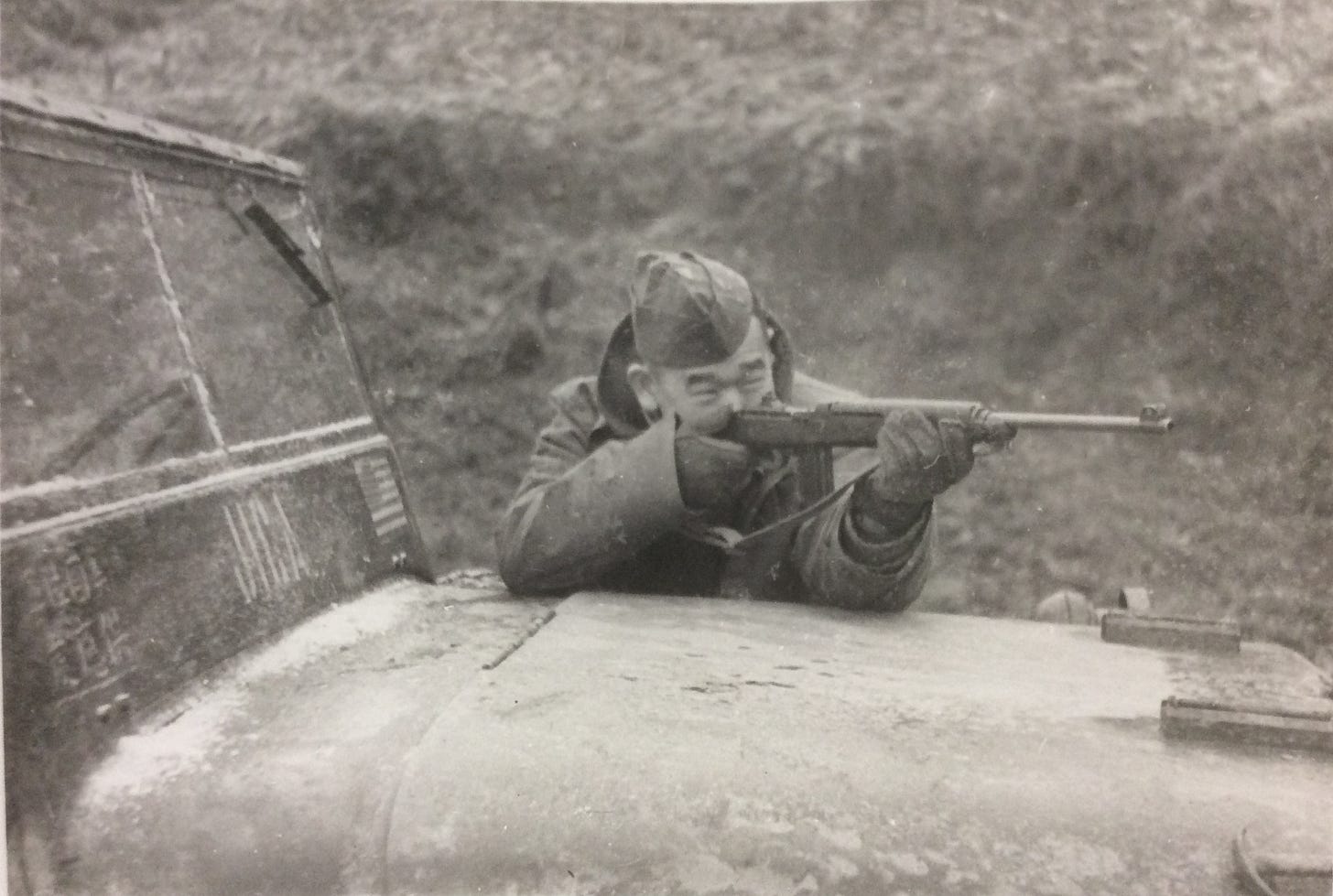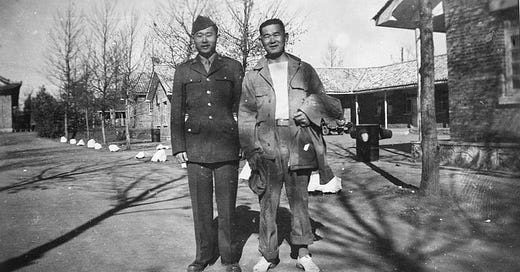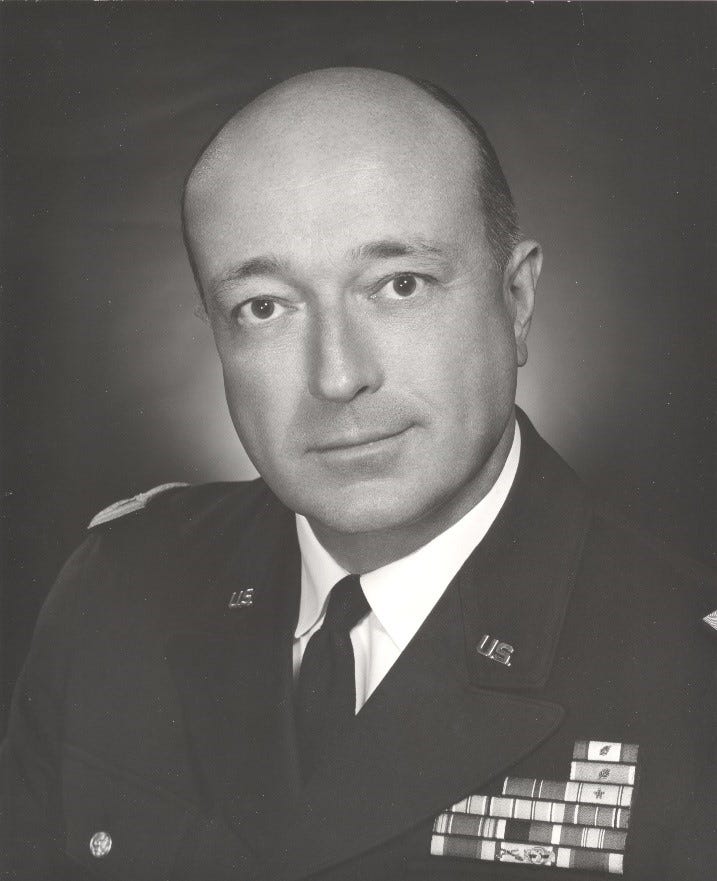In Chongqing, Colonel DePass immediately had Peter Kim apply for enlistment into the U.S. Army. Not being a U.S. citizen delayed his induction, though, since special authorization was required before a foreign national could become an American soldier. The background investigation and bureaucratic process dragged on for months, time that Peter used to reconnect with family and old friends from Shanghai.
Finding his long-lost brother James came first. He had last seen James in 1937 had heard nothing from him since December 7, 1941. His friend Roy McNair used his position as an Army captain and the Assistant Military Attache to China to work through the Army’s globe-spanning bureaucracy to find James. McNair succeeded and informed Peter that his younger brother was not only alive, he was Lieutenant James Kim, an officer in the 40th Infantry Division in the Pacific. Peter wrote letters to James at the 40th Infantry Division’s Army Post Office number and eventually heard back from him through V-mail, a Second World War military postal system that used microfilm to transport miniaturized photocopies of letters.
After three months of waiting, official approval of Peter’s enlistment finally arrived. On September 30, 1944, he swore the oath to defend the United States against all enemies and became Private Kim, U.S. Army. At last, he was an American soldier, starting at the very bottom of its enlisted ranks.

Assigned to the Army’s Military Intelligence Service (MIS), Private Kim went to the Joint Intelligence Collection Agency (JICA), a joint intelligence center in Chongqing. He immediately became JICA’s expert on Japanese-occupied China. With his first-hand knowledge of Shanghai and other areas that few Americans had seen for years, Peter soon became known widely known and in demand in other intelligence organizations. The OSS, the Fourteenth Air Force, and the China Theater General Staff intelligence section were among the organizations that obtained him on detail from JICA in the months that followed.
Richard Kim enlisted as well in distant Kunming. He had arrived at the main U.S. air and logistical base in China in October, at the end of the long retreat from Kweilin. There he was taken in by Ernest Moy, the estranged husband of Peter’s girlfriend Ruth Moy. Ernest Moy had no apparent hard feelings toward Peter’s younger brother and gave Richard a place to live in the house that he had as a senior Nationalist Chinese official with the War Area Service Corps (WASC), the organization that supported U.S. military forces in China. Only 17 years of age, he succeeded in lying about his age to enlist with the help of a letter from Captain Roy McNair attesting that he was 18. Richard was sworn in as an enlisted man in the U.S. Army on December 7, 1944.

The Army Services of Supply (SOS) became Richard’s first assignment and soon drew on Peter’s expertise as well. In February 1945, the Army SOS requested PFC Peter Kim to send on a fact-finding mission outside of Changsha, then retained him on an extended detachment from JICA. The SOS gave Peter a free hand to survey Japanese-occupied coastal areas for supply sources.
On his own initiative, Peter used his spare time to collect information on the Shanghai civilian internment camps. One day, he hoped, his work would help to liberate his friends and compatriots in the camps and save American lives.
An officer with SOS became another friend who sought to help Peter. Lieutenant Robert Peaslee, a Minnesota native from a family with Republican Party connections, took an immediate liking to Peter and arranged to have him transferred from JICA to the China Theater General Staff in Chongqing. In July 1945, Peter moved to the General Staff’s Civil Affairs section, called the G-5 in Army terminology. There he took on a special role under two high-ranking officers, G-5 commander Brigadier General George Olmsted and his deputy Colonel Marshall Carter.
General Olmsted was a 1922 graduate of West Point who had become a successful businessman in insurance during the 1920s and 1930s. Recalled to active duty in January 1942, he had managed the global Lend-Lease military assistance program, then was promoted to brigadier general and sent to China to establish the G-5 general staff section in 1944. After the war he would use his fortune to endow the Olmsted Foundation, whose Olmsted Scholar Program became a premier foreign education program for U.S. military officers.
Colonel Carter was a 1931 graduate of West Point who would become a key leader of the postwar U.S. intelligence community. General George C. Marshall chose Carter as one of his aides while serving as Special Envoy to China in 1946, then retained him during his appointments as Secretary of State in 1947-1949 and Secretary of Defense in 1950-1951. Carter ascended to become a lieutenant general, deputy commander of U.S. forces in Korea, and a leader of two of the main U.S. intelligence agencies, serving as Deputy Director of Central Intelligence in 1962-1965 and as the fifth Director of the National Security Agency in 1965-1969.
Olmsted and Carter recognized Peter as an exceptionally valuable asset and a natural leader, although he still held a low enlisted rank as a Technician Fifth Grade (T/5), between a private and a corporal. They entrusted him with independent actions that normally only an officer would perform. Among them was the planning of a mission to liberate the civilian internment camps of Shanghai and preserve the lives of the thousands of people confined in them, his independent project for the past several months. General Olmsted even promised Peter that when the time finally came for this mission, he would have an opportunity to lead it. No one had any idea in July 1945 when such a mission could ever happen, though.
This series previews my upcoming book Victory in Shanghai: A Korean American Family’s Journey to the CIA and the Army Special Forces, whose publication is expected by June 1, 2025. You can pre-order it now through Potomac Books, an imprint of the University of Nebraska Press, at this link, or through your favorite local independent bookseller.
Subscription to this series is free.
If you know anyone who may be interested in this series, please share it with them.







